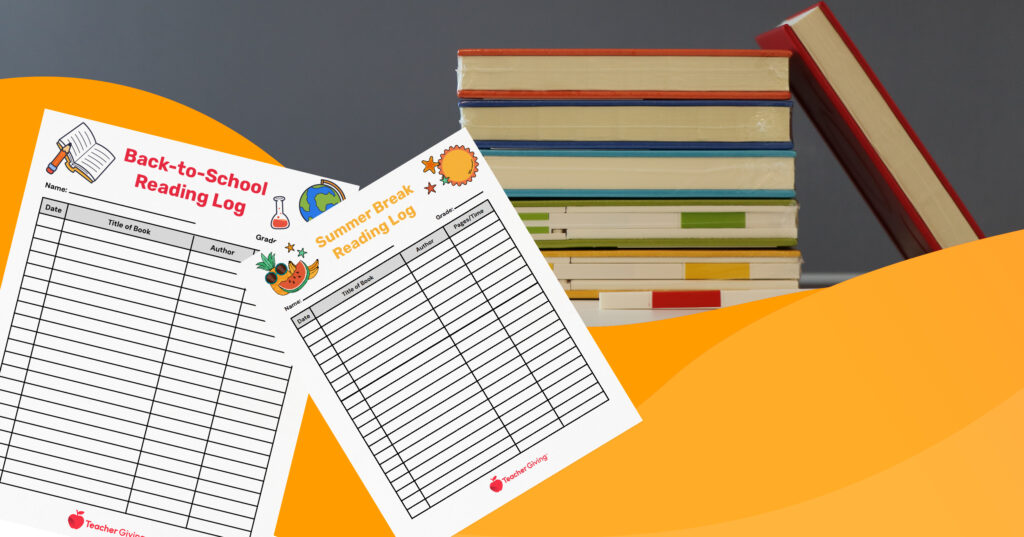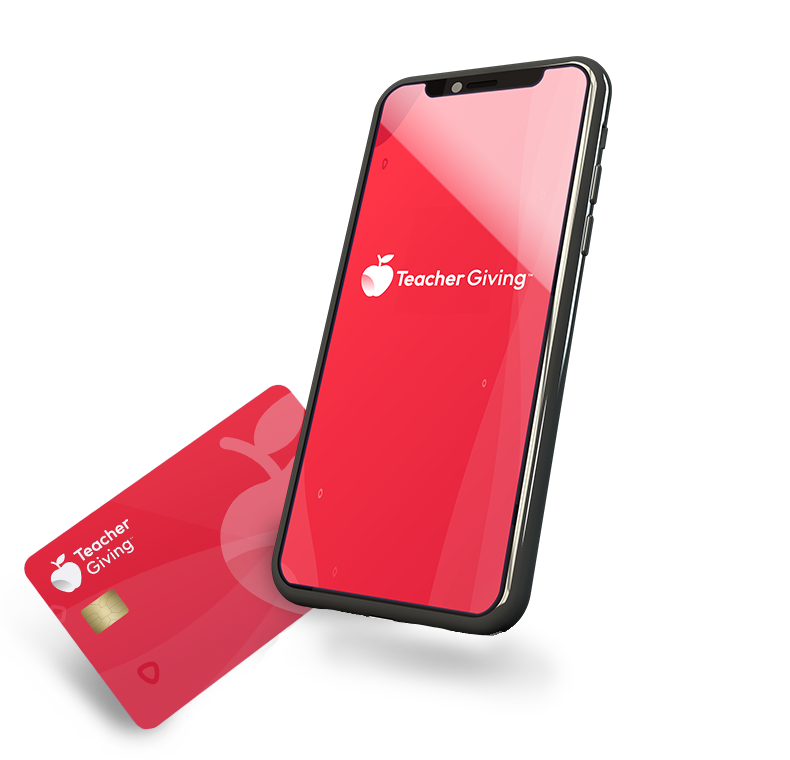Here at TeacherGiving, our goal is simple: to bridge the gap between what schools need and what traditional funding sources provide, ensuring every teacher has the tools to inspire and help their students succeed. Along with financial support through crowdfunding, we also offer a range of free resources that contribute to that mission.
Our latest resource is a set of seasonal reading logs designed to keep students engaged in reading throughout the year. With themed logs for Back-to-School, Fall Break, Winter Break, Spring Break, and Summer, these printable sheets are designed to motivate students, track their progress, and keep them eager to read all year round.
Consistent Reading Habits: Key to Student Success
Consistent reading habits are essential for student success and have a profound impact on various aspects of academic and personal growth. Here’s why:
Development of Literacy Skills
Regular reading helps students develop strong literacy skills, including comprehension, vocabulary, and critical thinking. By consistently engaging with texts, students enhance their ability to understand and interpret complex materials across subjects.
Enhanced Academic Performance
Reading is foundational to all areas of learning. Whether solving math problems, exploring scientific concepts, or studying history, strong reading skills improve students’ ability to grasp and apply knowledge. This leads to better performance in both classroom activities and standardized tests. Studies have shown that even reading to infants could help increase their future academic success!
Expansion of Vocabulary
Exposure to various texts introduces students to new words and phrases, significantly expanding their vocabulary. A rich vocabulary supports better communication and understanding in all academic and social contexts.
Boost in Confidence
Regular reading builds students’ confidence in their academic abilities. As they see improvement in their reading skills and comprehension, they gain a sense of accomplishment that translates into increased self-assurance in their overall studies. There is even some evidence to suggest that readers have 10% higher self-esteem than those who don’t read regularly.
Critical Thinking and Imagination
Reading stimulates critical thinking and creativity by encouraging students to analyze, question, and envision new scenarios. This cognitive development supports problem-solving skills and imaginative thinking.
Building a Strong Reading Foundation
Developing consistent reading habits early on establishes a strong foundation for future academic and personal growth. Students who read regularly are better prepared to tackle more complex texts and concepts as they advance in their education.
What is a Reading Log?
A reading log is a tool used to record and track a reader’s progress and experiences with their reading material. For students, it often includes:
- Book Information: Details like the title, author, and genre of the book.
- Reading Dates: When the student started and finished the book or reading session.
- Reading Time: The amount of time spent reading.
- Summary or Reflection: A brief description of the book or chapter, and the student’s personal thoughts or impressions.
- Goals and Achievements: Targets like the number of books or pages read, and celebrations for reaching milestones, such as marks or stickers.
- Additional Activities: Engaging prompts or activities related to the book, such as drawing a scene from the story, writing a short review, or answering questions to deepen understanding.
Themed Reading Logs: Why They Work
Themed reading logs are a powerful tool for maintaining student interest and encouraging them to read when they’re not at school.
Here’s why they are so effective:
- Seasonal Interest and Excitement: Our themed reading logs align with different times of the year—Back-to-School, Fall Break, Winter Break, Spring Break, and Summer—making them relevant and timely. This seasonal approach captures students’ interest and keeps reading fresh and exciting, especially when compared to a traditional reading log that often seems like more of a burden.
- Increased Motivation: These themed logs enhance motivation by incorporating themes that resonate with students’ current experiences and interests. Students are more likely to engage with reading when it feels connected to their everyday lives.
- Goal Setting and Tracking: Reading logs provide a structured way for students to set reading goals and track their progress. This organization helps students stay focused and committed to their reading routines. Having a fun theme is just the icing on top!
- Reflective Practices: Our themed logs include prompts and activities that encourage students to reflect on their reading. This reflection helps deepen comprehension and allows students to connect their reading experiences with personal growth.
- Celebration of Achievements: Many teachers implement rewards and recognition when students reach certain reading milestones. Celebrating these achievements boosts students’ confidence and reinforces positive reading habits.
- Personalization and Choice: Themed reading logs allow students to choose books related to the theme, catering to individual interests and reading levels. This personalization ensures that students are more engaged and invested in what they’re reading.
Overview of the Reading Logs
Our resource pack includes five themed reading logs tailored to keep students engaged and motivated throughout the different seasons of the school year. Here’s a detailed look at each one:
1. Back-to-School Reading Log
Purpose: To start the school year by setting a strong reading foundation.
Features:
- Goal Setting: A dedicated space for students to set personal reading goals for the new school year.
- Routine Development: Encourages students to establish a consistent reading schedule.
- Book Recording: Sections to record titles, authors, and dates read.
- Personal Reflections: Prompts for students to jot down their thoughts about each book or reading session.
Benefits: Helps students create a reading routine from the outset, aligning their reading goals with the academic year.
2. Fall Break Reading Log
Purpose: To keep students engaged in reading during the fall break with seasonal activities.
Features:
- Autumn-Themed Activities: Fun prompts and activities inspired by fall, such as pumpkin-themed reading challenges or harvest stories.
- Book Selection: Encourages reading books that fit the autumn theme, from spooky tales to cozy mysteries.
- Progress Tracking: Sections to log reading time, book details, and personal insights.
- Seasonal Goals: Challenges and incentives related to fall to keep students motivated.
Benefits: Integrates reading with the fall season, making it relevant and engaging while encouraging continuous reading during the break.
3. Winter Break Reading Log
Purpose: To sustain reading habits during the winter holidays with festive and cozy activities.
Features:
- Holiday-Themed Challenges: Special reading challenges and activities related to winter holidays, like reading a holiday classic or writing a letter to a book character.
- Cozy Reading Ideas: Suggestions for creating a comfortable reading nook, such as using blankets and pillows to create a cozy fort.
- Tracking Details: Sections to record reading times, book titles, and reflections on each read.
- Winter Incentives: Rewards and milestones for meeting reading goals over the winter break.
Benefits: Keeps students engaged in reading during a festive and often busy time, turning winter break into an opportunity for rewarding reading experiences.
4. Spring Break Reading Log
Purpose: To maintain and enhance reading habits during the spring break with lively and interactive activities.
Features:
- Spring-Themed Prompts: Engaging activities related to spring, like nature-inspired reading scavenger hunts or a spring-themed book report.
- Diverse Book Lists: Encourages exploring books that celebrate growth, nature, and new beginnings.
- Reflection Areas: Space for students to reflect on their reading experiences and progress.
- Spring Rewards: Incentives for completing reading goals, such as bookmarks or stickers with spring designs.
Benefits: Makes reading a vibrant part of spring break, connecting students’ reading experiences with the season’s themes of renewal and growth.
5. Summer Reading Log
Purpose: To foster a love for reading during summer vacation with exciting challenges and rewards.
Features:
- Summer Reading Challenges: Fun and interactive challenges designed for the summer months, such as reading under the stars or completing a summer reading bingo.
- Book Tracking: Areas to log the titles, authors, and reading times for books read during the summer.
- Reflection and Goals: Prompts for students to reflect on their summer reading experiences and set new reading goals.
- Summer Rewards: Special rewards for reaching reading milestones, encouraging students to continue reading through the vacation.
Benefits: Keeps students motivated and engaged in reading during the summer, preventing the “summer slide” and making reading an enjoyable and integral part of their summer activities.
Using the Reading Logs
To download your free reading logs, simply click here to access the PDF files. Once downloaded, save the files to your computer or device for convenient access.
Open the downloaded PDFs and review each reading log to familiarize yourself with their content. Print the logs using standard paper size (8.5” x 11”) for easy handling. For added durability, consider using heavier paper or laminating the logs.
Distribute the printed logs to your students individually or in groups, depending on your classroom setup, ensuring they have everything they need to start tracking their reading adventures.
Tips for Success with Reading Logs
- Introduction to Reading Logs: Start by introducing the concept of reading logs to your students. Explain how they will be using these logs to track their reading throughout the year.
- Showcase Each Log: Display each of the five themed reading logs and discuss the seasonal themes. Highlight any special features or prompts on the logs.
- Demonstrate Usage: Walk students through filling out a sample entry on the reading log. Show them how to record the title, author, pages read, and any reflections or notes.
- Goal-Setting Sessions: Dedicate a class period to setting personal reading goals. Provide examples of different types of goals, such as the number of books to read per month or a specific number of reading minutes per week.
- Customizable Goals: Encourage students to personalize their goals based on their reading levels and interests. This makes the goals more attainable and meaningful.
- Documenting Goals: Have students write their goals on their reading logs. This written commitment can serve as a powerful motivator.
- Design a Cozy Reading Corner: Set up a dedicated space in the classroom with comfortable seating, good lighting, and a variety of books. Adding cushions, rugs, and bean bags can make the area inviting and encourage students to spend time reading. While reading logs are primarily to track reading at home, having a space like this encourages students to dive into their books whenever they have free time in the classroom.
- Stock Seasonal Books: Keep a selection of books related to current themes or seasons available in the reading corner. Rotate these books periodically to keep the collection fresh and engaging.
- Themed Projects: Design projects or assignments based on the themes of the reading logs. For instance, after a fall-themed reading log, have students write or present on a fall-related topic they read about.
- Parental Involvement: Have students share their reading logs with their families, fostering a home-school connection and reinforcing reading habits outside the classroom. Instead of merely signing off on their children’s logs, encourage parents to ask detailed questions about their kids’ books and get involved with the reading journey.
Tracking Progress and Celebrating Wins
- Regular Check-Ins: Schedule regular intervals to review students’ reading logs. This could be weekly or bi-weekly check-ins where students share their progress.
- Progress Charts: Create a classroom reading progress chart where students can add stickers or marks to represent each book they complete. This visual aid can boost motivation.
- Peer Sharing: Allow time for students to share what they’re reading with their peers. This can be done through brief presentations or small group discussions.
- Celebrating Milestones: Recognize and celebrate when students reach their reading goals. This can be done through certificates, small rewards, or a group classroom celebration.
- Reflection Activities: Incorporate activities where students reflect on their reading journey. They can write about their favorite books, what they’ve learned, and how their reading habits have changed.
Supporting Student Success With TeacherGiving
At TeacherGiving, we are dedicated to supporting educators by providing valuable resources through our innovative crowdfunding platform. We believe that by empowering educators, we can help build a brighter future for all students.
Fostering a love of reading in students has far-reaching benefits. It not only improves their academic performance but also opens up new worlds of imagination, knowledge, and understanding. By using these reading logs, you can inspire your students to become lifelong readers, critical thinkers, and enthusiastic learners.
We encourage all educators to take advantage of our free seasonal reading logs. These resources are designed to make reading a fun and engaging activity for students throughout the year.
For more free resources and to learn how you can create a crowdfunding campaign for your classroom, visit the TeacherGiving website. Discover additional tools and support designed to make a difference—in ways that really matter.



